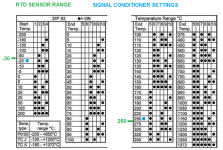Good day all,
I am having bit of an issue getting my head around this RTD scaling issue. Be forewarned, my head has been known to be "THE" issue for quite sometime.
PHYSICAL DEVICES:
RTD - OMEGA 4 Wire -30 to 260 C PT100 RTD
Signal conditioner - OMEGA PRCTL series 2, 3, or 4 wire RTD to 4-20mA output. The signal fed to the PLC is scaled according to the signal conditioner settings (blue marking) in the chart below.
Issue:
I am about 2 degrees off with these settings. This is the closest I can get to the actual temp. Any higher or lower ranges in the signal conditioner settings skews the actual temp by more than +/- 5 Deg C.
REFERENCE:
In the same loop is a Brooks Automation precision Mass Flow controller with a built in RTD. It consistently reports around 31.5 Deg C which in fact is the correct temperature in the process loop.
Help Needed:
How do I correctly scale this RTD with this Particular signal condition to the range I need so that I am within 0.5 DEG C of the reading from the MASS FLOW CONTROLLER? I do not care about the lower range in this instance. Just the ambient inside the process loop which can never be above 32 C or below 28 C.
SIDE NOTE FYI.
Mass Flow Controller - $5,000 (Used buy one of worlds top 3 semiconductor equipment manufactures and dictated by them that we use it on this test jig.
RTD - OMEGA RTD ~$170
SIG Conditioner - OMEGA Signal Conditioner ~$230
We use OMEGA's -200 to +850C RTD's with this same signal conditioner for this very same customer and they work flawlessly,for both HI-TEMP and Cryogenic applications.
Any thought or suggestions on how to go about properly scaling this RTD with this specific signal conditioner in this particular scenario?
Many Thanks.
Cheers!

I am having bit of an issue getting my head around this RTD scaling issue. Be forewarned, my head has been known to be "THE" issue for quite sometime.
PHYSICAL DEVICES:
RTD - OMEGA 4 Wire -30 to 260 C PT100 RTD
Signal conditioner - OMEGA PRCTL series 2, 3, or 4 wire RTD to 4-20mA output. The signal fed to the PLC is scaled according to the signal conditioner settings (blue marking) in the chart below.
Issue:
I am about 2 degrees off with these settings. This is the closest I can get to the actual temp. Any higher or lower ranges in the signal conditioner settings skews the actual temp by more than +/- 5 Deg C.
REFERENCE:
In the same loop is a Brooks Automation precision Mass Flow controller with a built in RTD. It consistently reports around 31.5 Deg C which in fact is the correct temperature in the process loop.
Help Needed:
How do I correctly scale this RTD with this Particular signal condition to the range I need so that I am within 0.5 DEG C of the reading from the MASS FLOW CONTROLLER? I do not care about the lower range in this instance. Just the ambient inside the process loop which can never be above 32 C or below 28 C.
SIDE NOTE FYI.
Mass Flow Controller - $5,000 (Used buy one of worlds top 3 semiconductor equipment manufactures and dictated by them that we use it on this test jig.
RTD - OMEGA RTD ~$170
SIG Conditioner - OMEGA Signal Conditioner ~$230
We use OMEGA's -200 to +850C RTD's with this same signal conditioner for this very same customer and they work flawlessly,for both HI-TEMP and Cryogenic applications.
Any thought or suggestions on how to go about properly scaling this RTD with this specific signal conditioner in this particular scenario?
Many Thanks.
Cheers!





